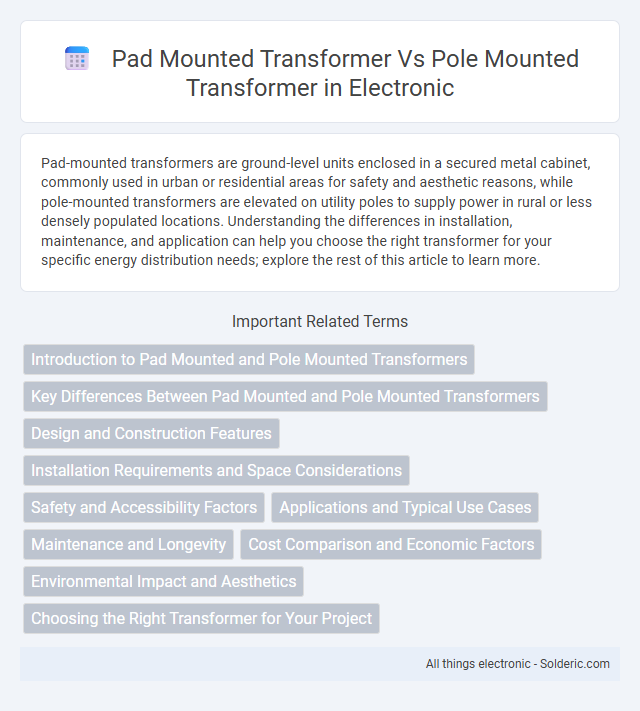Pad-mounted transformers are ground-level units enclosed in a secured metal cabinet, commonly used in urban or residential areas for safety and aesthetic reasons, while pole-mounted transformers are elevated on utility poles to supply power in rural or less densely populated locations. Understanding the differences in installation, maintenance, and application can help you choose the right transformer for your specific energy distribution needs; explore the rest of this article to learn more.
Comparison Table
| Feature | Pad Mounted Transformer | Pole Mounted Transformer |
|---|---|---|
| Installation Location | Ground level on concrete pad | Mounted on utility poles |
| Usage | Underground electrical distribution | Overhead electrical distribution |
| Accessibility | Easily accessible at ground level | Requires climbing poles for service |
| Maintenance | Simple and safer maintenance | Complex and potentially hazardous |
| Protection from Elements | Enclosed and protected | Exposed to weather |
| Security | Lockable enclosure for safety | Less secure, exposed |
| Typical Voltage Range | Up to 35 kV primary voltage | Up to 35 kV primary voltage |
| Application | Urban and suburban underground networks | Rural and overhead networks |
| Cost | Higher initial installation cost | Lower installation but higher maintenance cost |
Introduction to Pad Mounted and Pole Mounted Transformers
Pad mounted transformers are ground-level electrical devices housed in a secure, weather-resistant enclosure, commonly used in residential and commercial areas for low-voltage distribution. Pole mounted transformers are elevated on utility poles, enabling easier installation and maintenance in rural or dispersed locations, and are designed to handle higher voltage inputs. Understanding the differences ensures your electrical infrastructure is optimized for safety, accessibility, and power distribution efficiency.
Key Differences Between Pad Mounted and Pole Mounted Transformers
Pad mounted transformers are installed at ground level within a secure enclosure, providing easy access for maintenance and enhanced safety in urban or residential areas. Pole mounted transformers are mounted on utility poles, elevating them above ground to save space and protect them from flooding, making them ideal for rural or less accessible locations. Your choice depends on factors such as space availability, safety requirements, and the environment where the transformer will be installed.
Design and Construction Features
Pad mounted transformers feature enclosed, grounded metal cabinets designed with safety and aesthetics in mind, ideal for urban and residential areas with limited space. Pole mounted transformers are compact, weather-resistant units mounted on utility poles, allowing easy access for maintenance while minimizing ground-level footprint. Your choice depends on site constraints, load requirements, and environmental considerations related to these distinct design and construction features.
Installation Requirements and Space Considerations
Pad-mounted transformers require a secure, level concrete pad and adequate clearance for maintenance, making them suitable for residential or commercial areas with limited overhead space. Pole-mounted transformers are installed on utility poles, necessitating strong poles and sufficient height clearance, optimizing space in congested urban streets or rural settings. Both installations must comply with local electrical codes and consider accessibility for repair and safety.
Safety and Accessibility Factors
Pad-mounted transformers offer enhanced safety by being enclosed in grounded, weatherproof steel cabinets that reduce the risk of accidental contact and vandalism, making them suitable for residential areas with pedestrian traffic. Pole-mounted transformers are elevated, limiting unauthorized access and minimizing hazards at ground level, but pose challenges for maintenance workers who require specialized equipment for repairs. Your choice should consider the ease of safe accessibility for routine inspections while minimizing risks to the public and utility personnel.
Applications and Typical Use Cases
Pad mounted transformers are commonly used in residential neighborhoods, commercial complexes, and industrial facilities where underground power distribution systems are preferred for aesthetic and safety reasons. Pole mounted transformers are typically installed in rural or suburban areas where overhead power lines are standard, providing efficient stepped-down voltage for single or multiple users along distribution lines. Both transformer types serve distinct applications based on infrastructure, load requirements, and environmental considerations.
Maintenance and Longevity
Pad mounted transformers require less frequent maintenance due to their sealed, weather-resistant design, which protects internal components from moisture and contaminants. Pole mounted transformers, exposed to environmental elements, often need routine inspections and maintenance to ensure reliability and prevent failures. Your choice between these types can impact long-term operational costs and service interruptions based on their maintenance demands and expected lifespan.
Cost Comparison and Economic Factors
Pad-mounted transformers generally have higher initial installation costs due to underground cabling and site preparation, while pole-mounted transformers are less expensive to install on existing utility poles. Maintenance expenses tend to be lower for pad-mounted transformers because they offer better protection from weather and physical damage, reducing downtime and repair costs. Long-term economic benefits favor pad-mounted transformers in urban areas where aesthetics and safety regulations drive value despite higher upfront investments.
Environmental Impact and Aesthetics
Pad mounted transformers are typically enclosed and installed at ground level, reducing visual clutter and blending more seamlessly with landscaping, which minimizes their environmental footprint in residential areas. Pole mounted transformers are elevated, making them more exposed to weather conditions and potentially impacting bird habitats, while also being more visually intrusive in natural or urban settings. Your choice should consider local environmental regulations and aesthetic preferences to balance functionality with minimal ecological disruption and neighborhood appeal.
Choosing the Right Transformer for Your Project
Pad mounted transformers provide a safer, ground-level installation ideal for residential or urban projects where aesthetics and accessibility are important. Pole mounted transformers are suitable for rural or overhead power distribution, offering easier maintenance in areas with limited ground space. Your choice depends on factors like site layout, safety requirements, and local electrical codes to ensure optimal performance and reliability.
pad mounted transformer vs pole mounted transformer Infographic

 solderic.com
solderic.com